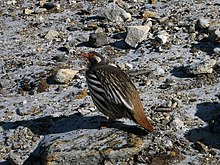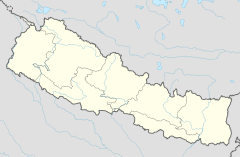Sagarmatha National Park
| Sagarmatha National Park | ||
|---|---|---|
| Mount Everest (Sagarmatha) from the west (Kala Pattar) | ||
|
|
||
| Location: | Nepal | |
| Surface: | 1148 km² | |
| Founding: | 1976 | |
| Sagarmatha National Park | |
|---|---|
|
UNESCO world heritage |
|
| National territory: |
|
| Type: | nature |
| Criteria : | (vii) |
| Surface: | 124,400 ha |
| Reference No .: | 120 |
| UNESCO region : | Asia and Pacific |
| History of enrollment | |
| Enrollment: | 1981 ( session 5 ) |
The Sagarmatha National Park is a national park in Nepal , in 1976 under the name of Sagarmatha National Park was founded and since 1979 UNESCO World Heritage belongs. With an area of 1148 km², it takes up a large part of the Khumbu and borders the Tibetan Autonomous Region in the north . The national park is named after Mount Everest ( Nepali : सगरमाथा, Sagar = sky, matha = head, forehead; "forehead of heaven").
The landscape is characterized by rugged peaks - including the three eight-thousanders Mount Everest , Lhotse and Cho Oyu -, glaciers and valleys formed by glaciers and streams. In addition to the impressive mountain formations, some rare animal species and the cultural sites of the Sherpas living there were the reason for inclusion in the UNESCO World Heritage. In the east, the 2330 km² Makalu-Barun National Park borders directly on the Sagarmatha National Park.
climate
The national park is located in the eastern climatic zone of the Himalayas , where the monsoon rains begin as early as June and only subside in late September. In the months of October and November the weather is moderate with cool nights. From December to February it is also cold during the day with temperatures usually below 5 ° C. During these months it snows heavily from time to time. From March the days get warmer.
vegetation
The altitude levels of the protected area range from 2845 m to the highest point on earth at 8848 m. About 69% of the park consists of agriculturally unusable highlands at an altitude of over 5000 m, 28% are used as alpine pastures and for potato cultivation and only 3% are forested. These forests are located in the river valley of the national park and essentially consist of hemlocks in the lowest areas . Fir , juniper , birch and rhododendron predominate in the areas above . Even higher up, the forests give way to typical alpine plant communities. Above 5000 m, the land is bare and consists of rock, snow and ice.
fauna

The national park is a habitat for snow leopards , wolves, little panda bears , yellow-bellied musk deer ( Moschus chrysogaster ), Himalayan tahri ( Hemitragus jemlahicus ), gorals, seraue, great martens , Himalayan marmots and whistling hares (Ochotonidae). Rhesus monkeys , black bears , Hulmans and Muntjak deer also occur in the lower elevations .
The snow leopard was exterminated in the Nepalese part of the Everest complex in the 1960s, but was able to repopulate the area from Tibet and is now found in the national park. This is mainly due to the increased numbers of tahr and musk deer. Overall, the acceptance among the local Sherpas , who live mainly from cattle breeding but also from increasing tourism, seems to be relatively high. The wolf , which is more feared by shepherds because it can even kill adult yaks , has been extinct since the 1980s and is still missing in the national park area. This indicates that this predator has become rare on the Tibetan side. Leopards that could inhabit the lower elevations were not found in a recent study in the national park. However, red foxes and golden jackals have been shown to occur.
Ornithologists have identified more than 118 bird species, including the Himalayan pheasant ( Lophophorus impejanus ), Himalayan king chicken ( Tetraogallus himalayensis ) and blood pheasant ( Ithaginis cruentus ). The small lakes at higher elevations are important gathering points for migratory birds , especially for water birds .
tourism
The Sagarmatha National Park lives mainly from tourism. It is a popular destination for high-altitude climbers and trekking tourists, who are mostly on the Mount Everest Trek . The park entrance is near Monju . The entry price is 3000 NRs (around 27 euros, as of 2013).
Individual evidence
- ↑ a b UNESCO World Heritage Center: Sagarmatha National Park. Retrieved August 29, 2017 .
- ↑ KK Gurung & Raj Singh: Field Guide to the Mammals of the Indian Subcontinent , Academic Press, San Diego, ISBN 0-12-309350-3 (pp. 78-79)
- ↑ Som B. Ale, Pralad Yonzon and Kamal Thapa: Short Communication: Recovery of snow leopard Uncia uncia in Sagarmatha (Mount Everest) National Park, Nepal. Oryx Vol 41 No 1 January 2007
Web links
- Sagamartha National Park on enzyclopedia of earth
- Entry on the UNESCO World Heritage Center website ( English and French ).



